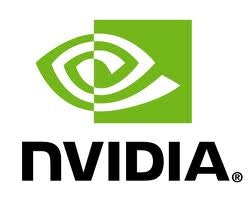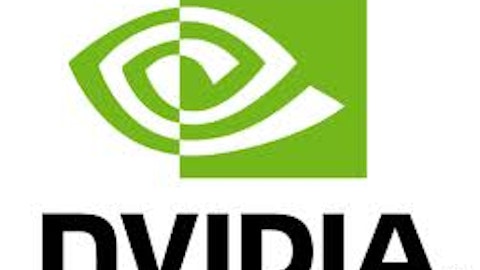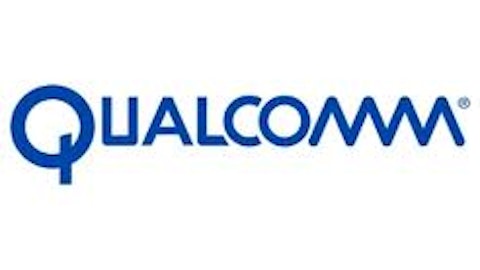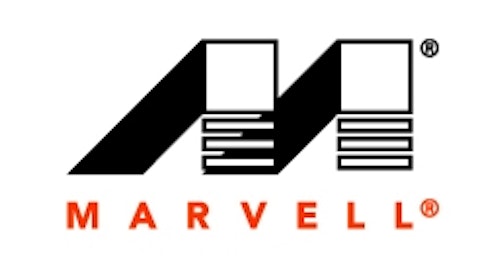
The world of technology has been shifting hands. With devices becoming more compact, the onus lies on the microchip manufactures on how great a punch they can deliver in the smallest packages.
NVIDIA Corporation (NASDAQ:NVDA), a manufacturer of graphics chips for smartphones, PCs, and tablets, reported its earnings for Q4 2013, which met analysts’ expectations on revenue, and beat the consensus expectation on EPS.
The company reported revenue of $1.11 billion, 16% higher than prior-year quarter’s $953.2 million. GAAP earnings were $0.28 per share for Q4, 56% higher than the prior-year quarter’s $0.18 per share. Adjusted profit was $0.35 a share. The growth was on account of higher Tegra sales and its growing GPU business.
NVIDIA Corporation (NASDAQ:NVDA) claims that its ‘graphics processing unit’ market share has increased from 53% to 65%, and its notebooks market share has improved from 47% to 66%,compared to last year. NVIDIA’s new Kepler GPU architecture is the first design that comprises virtualization technology built right into the GPU. The introduction of the new design has helped in elevating market share and margins.
NVIDIA Corporation (NASDAQ:NVDA)’s Tegra processor’s sales increased 29% in fiscal 2013. Tegra 3 quad-core processors drive the world’s most popular devices, such as Google Inc (NASDAQ:GOOG)‘s Nexus 7, Microsoft’s Windows RT Surface tablet, Lenovo’s IdeaPad Yoga 11, and many more.
Moreover, NVIDIA Corporation (NASDAQ:NVDA) introduced the Tegra 4 processor, which is supposedly much better than its predecessor, Tegra 3. Tegra 4 is up to six times faster than Tegra 3, and is also LTE compatible. Currently, only QUALCOMM, Inc. (NASDAQ:QCOM) offers LTE-compatible chipsets, but NVIDIA, too, should penetrate the market once its Tegra 4 processor debuts.
The results and prospects no doubt look great, but currently a lot of rumors surround the company, like Google considering QUALCOMM, Inc. (NASDAQ:QCOM) over NVIDIA Corporation (NASDAQ:NVDA) for its next generation of Nexus tablets. These rumors, though, didn’t have any potential negative impact for the company.
NVIDIA Corporation (NASDAQ:NVDA) has a sturdy balance sheet with ample cash and no debt. The company has an annual yield of 2.43%, returning fair cash to its investors. It has been smart in the past, and made the right changes that have helped it perform and grow, such as moving into the high-end computing space with its Tesla Graphic Processing Units. I am positive about the company’s prospects.
Sheer winner
QUALCOMM, Inc. (NASDAQ:QCOM) dominates the chip manufacturing industry and is currently in a complete win-win situation, with its patent generating a smooth flow of cash. Its 3G network chips have a lot of potential, especially in emerging markets like India and China, where networks are now changing from 2G to 3G.
Furthermore, it has a first mover advantage in the 4G segment, since it is the only company that has a workable 4G solution. At present, barely 1% of all data traffic goes through 4G, but that proportion is expected to grow to 10% in the next five years. Qualcomm is going to benefit the most out of this growth, which should definitely improve its revenue and profit.
The company’s processor also has a good performance history. Windows’ premium phone, the Nokia Lumia 920, runs on Qualcomm’s Snapdragon dual-core processor. Qualcomm’s dominance in 4G LTE baseband hardware sales helped fuel manufacturers’ adoption of its Snapdragon S4 processors.
QUALCOMM, Inc. (NASDAQ:QCOM) has a well-diversified portfolio of businesses, and all are performing well. The explosion of smartphones in the emerging markets will help the company further strengthen its hold in the mobile market.
A look at Broadcom
Broadcom Corporation (NASDAQ:BRCM) has also entered the market for LTE chips. The company’s LTE solution, expected by next year, will support all technologies, and will be much smaller in size compared to its rivals. Its chip will compete with Qualcomm’s LTE chips, and will target high-end phones such as Apple Inc. (NASDAQ:AAPL)‘s iPhone and the 4G-enabled iPad.
The baseband market grew 15% year over year in the first half of 2012, and LTE is currently the highest growth segment in wireless networking. With only QUALCOMM, Inc. (NASDAQ:QCOM) as a major player in this market, Broadcom Corporation (NASDAQ:BRCM) has room to capture a healthy slice of the LTE sector for itself.
Foolish finale
The air around NVIDIA is still not clear, and is largely dependent on the success of its Tegra 4 processors, which are scheduled to start commercial production by the end of this year. It is a good company, and I believe it is worthy of being in a portfolio at its current price.
QUALCOMM, Inc. (NASDAQ:QCOM) is, without doubt, ruling the industry. It has a secured source of revenue generation with its number of patents. It is the only viable company providing 4G LTE solution at the moment, and is poised to benefit in the future as LTE continues to grow. In short, “Qualcomm is the safest pick in the industry at the moment.”
Broadcom Corporation (NASDAQ:BRCM), too, has good prospects but almost everything depends on 2014, when its LTE based chips hit the market. Investors with a longer horizon and in a position to park their money for a year or so, without much upside, should invest in this company.
The article The Chip in Your Phone Could be a Good Investment originally appeared on Fool.com and is written by Hemanshu Bhanushali.
Copyright © 1995 – 2013 The Motley Fool, LLC. All rights reserved. The Motley Fool has a disclosure policy.



